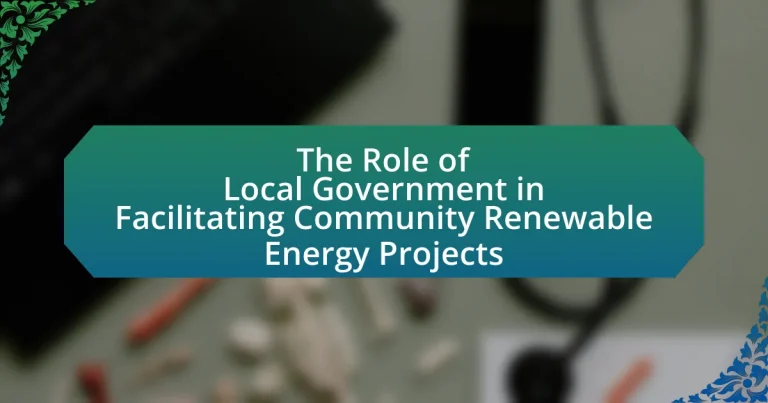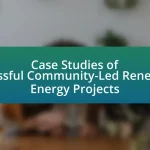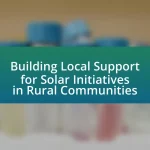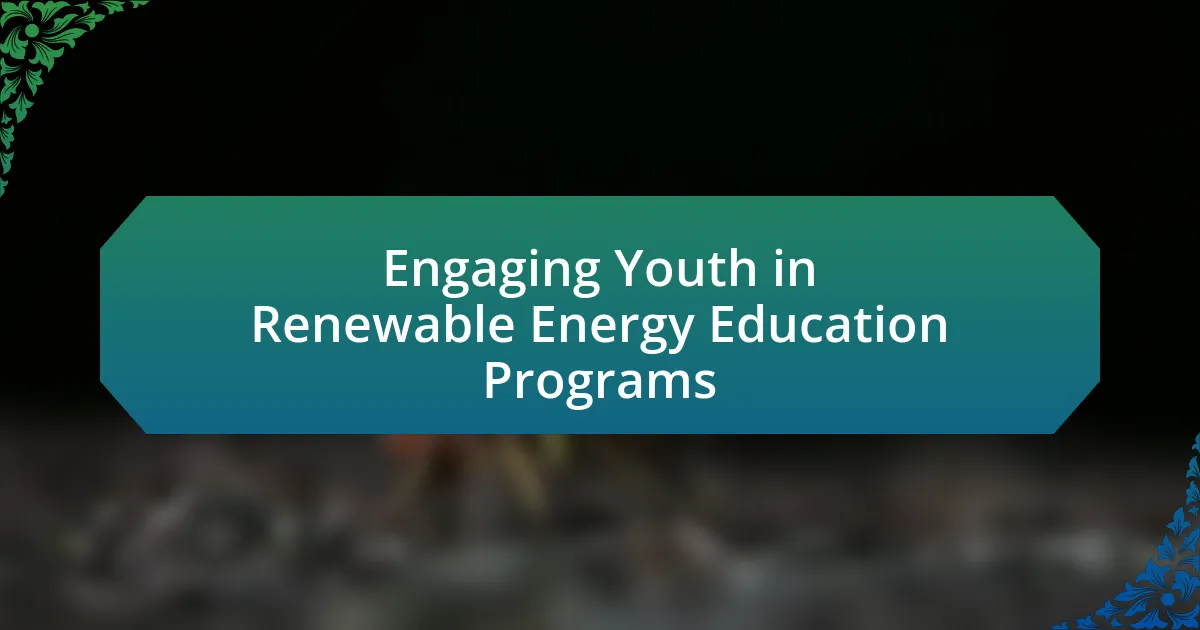Local governments play a vital role in facilitating community renewable energy projects by providing regulatory support, funding opportunities, and engaging with community stakeholders. They implement policies that streamline permitting processes, create financial incentives, and foster public participation, which enhances project feasibility and success rates. The article explores how local governments support renewable energy initiatives, the challenges communities face without their involvement, and best practices for effective engagement. It also highlights case studies that exemplify successful local government initiatives in promoting renewable energy, offering insights for future projects.
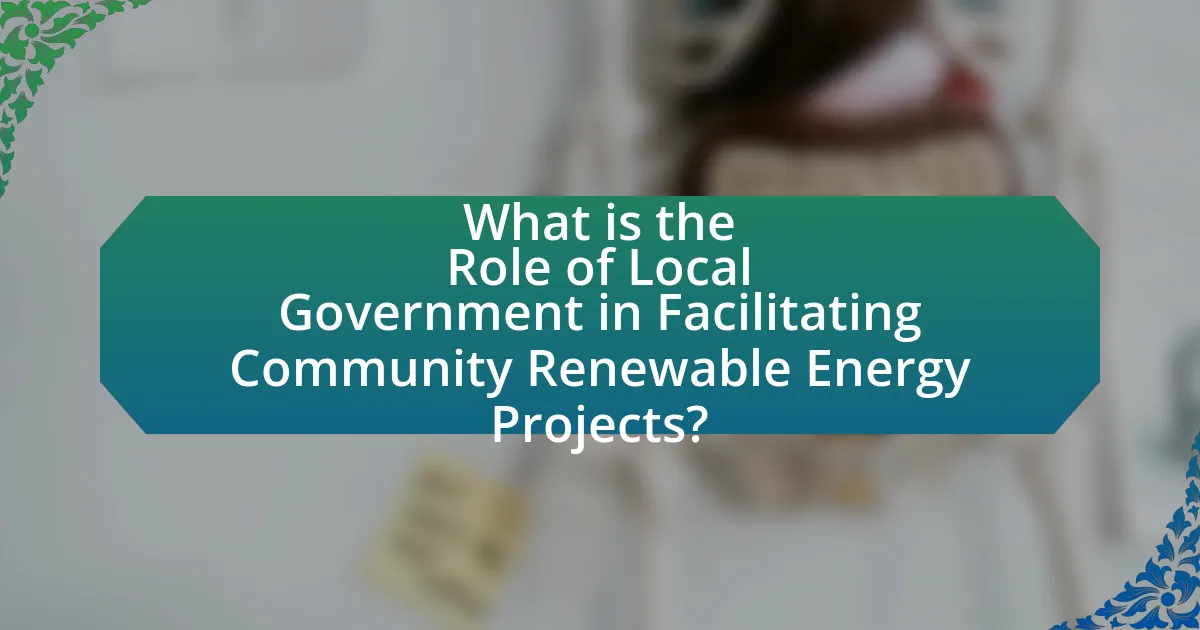
What is the Role of Local Government in Facilitating Community Renewable Energy Projects?
Local governments play a crucial role in facilitating community renewable energy projects by providing regulatory support, funding opportunities, and community engagement initiatives. They establish policies that streamline the permitting process for renewable energy installations, which can significantly reduce project timelines. For instance, local governments can implement zoning laws that favor renewable energy development and create incentives such as tax breaks or grants to encourage investment in these projects. Additionally, they often serve as a bridge between community members and larger energy stakeholders, ensuring that local voices are heard in the planning and implementation phases. This involvement not only fosters public support but also enhances the likelihood of project success, as evidenced by numerous case studies where local government engagement has led to increased adoption of renewable energy solutions in communities.
How do local governments support renewable energy initiatives?
Local governments support renewable energy initiatives by implementing policies, providing funding, and facilitating community engagement. They often create incentives such as tax credits, grants, and rebates to encourage the adoption of renewable technologies. For instance, a report from the National Renewable Energy Laboratory indicates that local governments have been instrumental in deploying solar energy projects, with over 50% of U.S. solar installations occurring in municipalities that offer supportive policies. Additionally, local governments may streamline permitting processes to reduce barriers for renewable energy projects, thereby accelerating their development and integration into the community.
What policies do local governments implement to promote renewable energy?
Local governments implement various policies to promote renewable energy, including incentives for solar and wind energy installations, zoning regulations that support renewable energy projects, and community education programs. For instance, many local governments offer tax credits or rebates for homeowners and businesses that install solar panels, which can significantly reduce the upfront costs and encourage adoption. Additionally, zoning laws may be adjusted to allow for the development of wind farms or solar farms in designated areas, facilitating the growth of renewable energy infrastructure. Community education initiatives often aim to raise awareness about the benefits of renewable energy and provide resources for residents to engage in sustainable practices. These policies collectively contribute to increasing the adoption of renewable energy sources at the local level.
How do local governments engage with community stakeholders in renewable energy projects?
Local governments engage with community stakeholders in renewable energy projects through public consultations, collaborative planning, and partnerships. These methods allow local governments to gather input, address concerns, and foster community support for renewable initiatives. For instance, many local governments hold town hall meetings and workshops to discuss project details and solicit feedback, ensuring that community voices are heard in the decision-making process. Additionally, local governments often collaborate with community organizations and stakeholders to co-develop renewable energy strategies, which can enhance project acceptance and effectiveness. This engagement is supported by studies showing that inclusive decision-making leads to higher community satisfaction and project success rates.
Why is local government involvement crucial for community renewable energy projects?
Local government involvement is crucial for community renewable energy projects because it ensures alignment with local needs and regulations. Local governments possess the authority to facilitate permitting processes, provide funding opportunities, and create supportive policies that encourage renewable energy initiatives. For instance, a study by the American Planning Association highlights that local governments can streamline the approval process for renewable energy installations, reducing project timelines and costs. Additionally, local governments often have access to community resources and can engage residents effectively, fostering public support and participation in renewable energy projects.
What challenges do communities face without local government support?
Communities face significant challenges without local government support, including limited access to funding, inadequate infrastructure, and lack of regulatory guidance. Without local government backing, communities often struggle to secure financial resources necessary for renewable energy projects, as they typically rely on government grants and incentives. Additionally, the absence of local government can lead to insufficient infrastructure development, making it difficult to implement and maintain renewable energy systems. Furthermore, without regulatory support, communities may encounter obstacles in navigating the complex legal landscape required for project approval and operation, which can hinder progress and discourage investment in sustainable energy initiatives.
How does local government involvement enhance project feasibility?
Local government involvement enhances project feasibility by providing essential support through regulatory guidance, funding opportunities, and community engagement. Local governments can streamline the permitting process, reducing bureaucratic delays that often hinder project timelines. For instance, a study by the National Renewable Energy Laboratory found that projects with local government support experienced a 30% faster approval rate compared to those without. Additionally, local governments can allocate public funds or incentives, making projects financially viable. They also facilitate community engagement, ensuring that projects align with local needs and garner public support, which is crucial for long-term success.
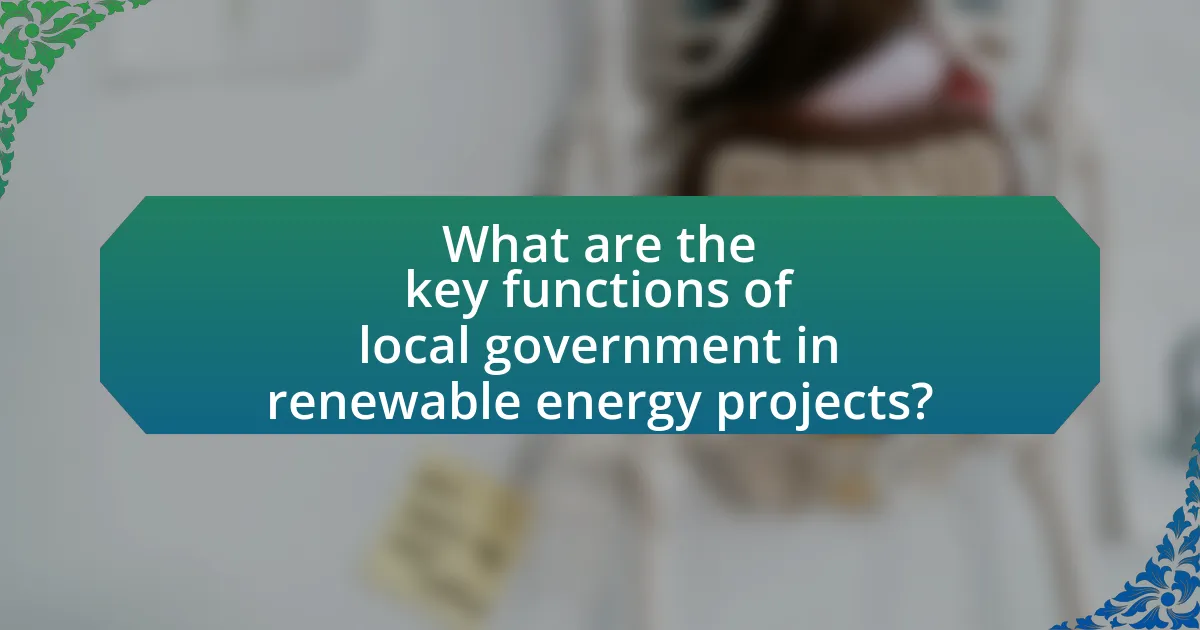
What are the key functions of local government in renewable energy projects?
Local governments play a crucial role in renewable energy projects by facilitating planning, permitting, and community engagement. They are responsible for creating and enforcing local regulations that govern the development of renewable energy infrastructure, such as solar farms and wind turbines. Additionally, local governments often provide financial incentives, such as tax breaks or grants, to encourage investment in renewable energy initiatives. They also engage with the community to gather input and address concerns, ensuring that projects align with local needs and priorities. This involvement is essential for the successful implementation of renewable energy projects, as evidenced by numerous case studies where local government support has led to increased project viability and community acceptance.
How do local governments facilitate funding for renewable energy initiatives?
Local governments facilitate funding for renewable energy initiatives through various mechanisms such as grants, tax incentives, and public-private partnerships. These entities often allocate budgetary resources specifically for renewable projects, enabling financial support for local initiatives. For instance, the U.S. Department of Energy reported that local governments can leverage federal funding programs, such as the Solar Energy Technologies Office, which provides financial assistance to municipalities for solar energy projects. Additionally, local governments may implement property tax exemptions or rebates for renewable energy installations, encouraging community investment. By fostering collaboration with private sector stakeholders, local governments can also create financing models that reduce upfront costs for renewable energy projects, thereby enhancing accessibility and promoting sustainable energy development within their communities.
What funding sources are available through local governments?
Local governments provide various funding sources for community renewable energy projects, including grants, loans, and tax incentives. Grants may come from state or federal programs aimed at promoting renewable energy initiatives, while loans can be offered through local development agencies to support project financing. Tax incentives, such as property tax exemptions or sales tax rebates, can also encourage investment in renewable energy projects. These funding sources are designed to reduce financial barriers and stimulate local investment in sustainable energy solutions.
How can communities access these funding opportunities?
Communities can access funding opportunities for renewable energy projects through local government programs, grants, and partnerships with non-profit organizations. Local governments often provide information on available funding sources, such as federal and state grants, which can be utilized for community renewable energy initiatives. For example, the U.S. Department of Energy offers various funding programs aimed at supporting community-based renewable energy projects, which local governments can help communities navigate. Additionally, local governments may facilitate workshops or informational sessions to educate communities about these funding opportunities, ensuring they understand the application processes and eligibility criteria.
What role does local government play in regulatory processes?
Local government plays a crucial role in regulatory processes by establishing and enforcing local laws and regulations that govern land use, zoning, and environmental standards. These regulations directly impact community renewable energy projects by determining where and how such projects can be developed. For instance, local governments often issue permits, conduct environmental reviews, and ensure compliance with state and federal regulations, which are essential steps for the successful implementation of renewable energy initiatives. Additionally, local governments may provide incentives or support for renewable energy projects, further influencing their development and integration into the community.
How do local governments streamline permitting for renewable energy projects?
Local governments streamline permitting for renewable energy projects by implementing simplified application processes and establishing clear guidelines. These measures reduce bureaucratic delays and enhance efficiency, allowing developers to navigate the permitting landscape more easily. For instance, many local governments have adopted standardized forms and checklists that outline necessary documentation, which minimizes confusion and accelerates review times. Additionally, some municipalities offer pre-application meetings to clarify requirements and address potential issues early in the process. According to a report by the National Renewable Energy Laboratory, jurisdictions that adopt these practices can significantly decrease the time required for project approvals, thereby fostering a more conducive environment for renewable energy development.
What regulations must communities comply with when implementing renewable energy projects?
Communities must comply with federal, state, and local regulations when implementing renewable energy projects. Federal regulations include the National Environmental Policy Act (NEPA), which requires environmental assessments for projects, and the Federal Energy Regulatory Commission (FERC) guidelines for energy generation and transmission. At the state level, regulations often involve obtaining permits from state energy offices and adhering to renewable portfolio standards that mandate a certain percentage of energy to come from renewable sources. Local regulations may include zoning laws, building codes, and land use permits that govern the installation of renewable energy systems. Compliance with these regulations ensures that projects meet safety, environmental, and community standards, facilitating smoother implementation and operation.
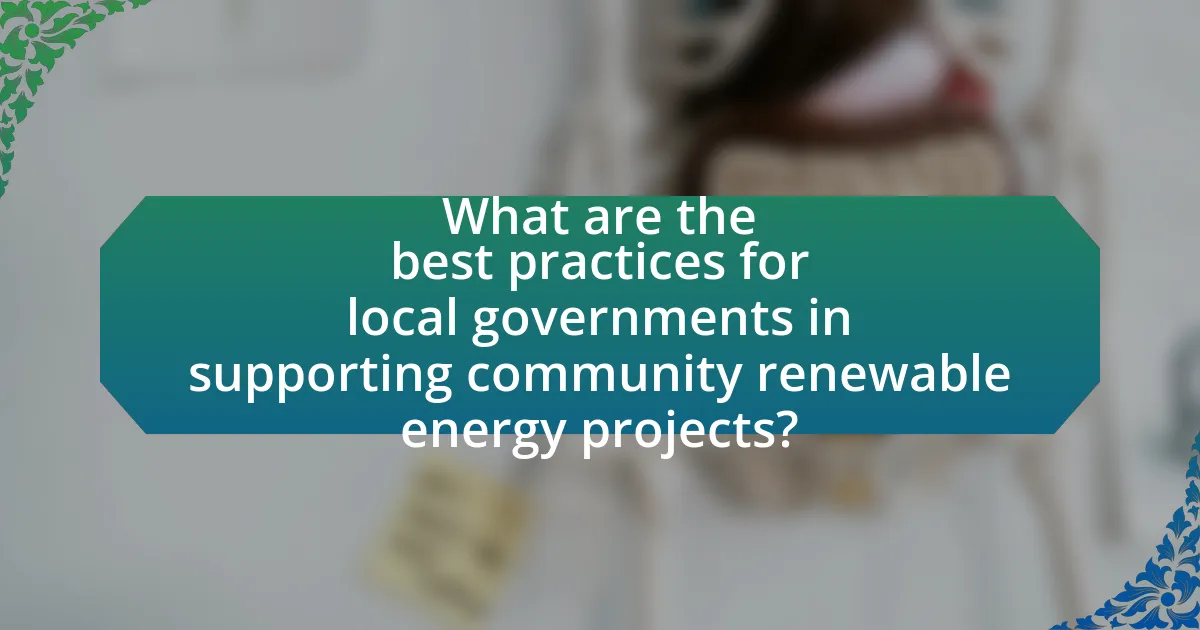
What are the best practices for local governments in supporting community renewable energy projects?
Local governments can effectively support community renewable energy projects by implementing policies that encourage local participation, providing financial incentives, and facilitating access to resources. Engaging the community through public consultations and educational programs fosters awareness and support for renewable initiatives. Financial incentives, such as grants or tax credits, can lower the barriers for project development, as evidenced by the success of programs in cities like San Diego, which saw a 50% increase in solar installations after introducing such incentives. Additionally, local governments can streamline permitting processes to reduce administrative burdens, thereby accelerating project timelines and enhancing community investment in renewable energy solutions.
How can local governments effectively engage with the community?
Local governments can effectively engage with the community by implementing transparent communication strategies and fostering participatory decision-making processes. These strategies include hosting public forums, utilizing social media platforms for outreach, and creating advisory committees that involve community members in discussions about renewable energy projects. Research indicates that communities with active local government engagement in energy initiatives report higher levels of public support and participation, as seen in studies conducted by the American Planning Association, which highlight the importance of inclusive practices in enhancing community trust and collaboration.
What strategies can be used to raise awareness about renewable energy benefits?
Effective strategies to raise awareness about renewable energy benefits include educational campaigns, community workshops, and partnerships with local organizations. Educational campaigns can utilize social media, local newspapers, and public service announcements to disseminate information about the environmental and economic advantages of renewable energy. Community workshops provide hands-on experiences and discussions that engage residents directly, fostering a deeper understanding of renewable technologies. Collaborating with local organizations, such as schools and environmental groups, can amplify outreach efforts and create a network of advocates who share information and resources. These strategies have been shown to increase public knowledge and acceptance of renewable energy, as evidenced by studies indicating that informed communities are more likely to support renewable initiatives.
How can local governments foster partnerships with local organizations?
Local governments can foster partnerships with local organizations by actively engaging in collaborative initiatives that align with community goals. This can be achieved through establishing formal agreements, hosting joint events, and creating advisory boards that include representatives from local organizations. For instance, the City of San Diego partnered with local nonprofits to develop the “Climate Action Plan,” which emphasizes renewable energy and sustainability, demonstrating how local governments can leverage community expertise and resources to enhance project outcomes. Such partnerships not only facilitate resource sharing but also ensure that community needs and perspectives are integrated into local energy initiatives.
What lessons can be learned from successful local government initiatives?
Successful local government initiatives demonstrate the importance of community engagement and collaboration in renewable energy projects. Engaging local stakeholders fosters trust and ensures that projects align with community needs, as seen in the Solarize program in Massachusetts, which resulted in a 300% increase in solar installations due to active community involvement. Additionally, successful initiatives highlight the need for clear communication and education about renewable energy benefits, which can lead to increased public support and participation. For example, the city of San Diego’s Climate Action Plan effectively communicated its goals, resulting in a 50% reduction in greenhouse gas emissions by 2035. These lessons underscore that local governments can drive successful renewable energy initiatives by prioritizing community involvement and transparent communication.
What case studies exemplify effective local government support for renewable energy?
Case studies that exemplify effective local government support for renewable energy include the city of San Diego, California, which has implemented a comprehensive Climate Action Plan aiming for 100% renewable energy by 2035. This plan includes initiatives such as solar energy incentives and community choice aggregation, which allows residents to choose renewable energy sources. Another example is the city of Burlington, Vermont, which became the first U.S. city to run on 100% renewable energy in 2014, primarily through investments in wind, solar, and biomass energy, supported by local government policies and funding. These cases demonstrate how local governments can effectively promote renewable energy through strategic planning and community engagement.
How can these case studies inform future projects?
Case studies can inform future projects by providing evidence-based insights into successful strategies and potential pitfalls in community renewable energy initiatives. For instance, analyzing the implementation of solar energy programs in various municipalities reveals that local governments that actively engage with community stakeholders and provide financial incentives tend to achieve higher participation rates. A study by the National Renewable Energy Laboratory found that communities with strong local government support saw a 30% increase in renewable energy adoption compared to those without such support. This data underscores the importance of local government involvement in fostering community engagement and ensuring project sustainability.
What practical steps can local governments take to enhance community renewable energy projects?
Local governments can enhance community renewable energy projects by implementing supportive policies, providing financial incentives, and facilitating community engagement. Supportive policies include zoning regulations that favor renewable energy installations and streamlined permitting processes, which can significantly reduce barriers for project development. Financial incentives, such as grants, tax credits, or low-interest loans, can encourage local investments in renewable technologies. Additionally, local governments can host workshops and informational sessions to educate the community about renewable energy benefits and opportunities, fostering greater public participation and collaboration in project planning and execution. These steps have been shown to increase the number and success rate of community renewable energy initiatives, as evidenced by successful programs in cities like San Diego and Boulder, which have seen significant growth in local renewable energy projects through such measures.
